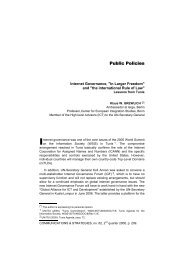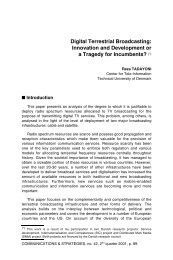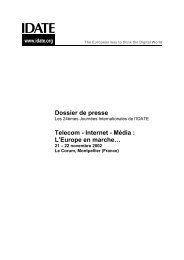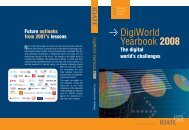Foundation
Foundation
Foundation
You also want an ePaper? Increase the reach of your titles
YUMPU automatically turns print PDFs into web optimized ePapers that Google loves.
110World2000 For NTT DoCoMo, i-mode represents a source of considerable complementary revenues, a springboard forthe deployment of its 3G network, a margin of independence vis à vis NTT as well as a vector for making upfor its globalisation initiatives. For the Japanese industry, i-mode's success and the propitious timing of thelaunch of 3G represent an international-scale opportunity for its manufacturers but, above all and ultimately,a highly promising chance to expand the video game, digital photo and video etc. markets by exploiting itsremarkable expertise in the fields of flat screen technologies and micro-electronics.Although Europe maintains a certain lead in 3G telephony over the US (auctions for the allocation of 3Glicences in the US are not likely to take place before September 2002), it is a lead that must be shared withJapan.Controversy in Europe over the methods for and levelsof allocation of UMTS licencesFaced with WAP's difficult launch, i-mode's success in Japan emerges as somewhat comforting, as it revealsthe existing market's potential for mobile Internet services once a significant marketing investment has beenmade. While the coming months should serve to indicate the extent to which European operators have learnedtheir lesson, the real test for top players is to be found in the opening up of 3G networks, referred to in Europeas UMTS (Universal Mobile Telecommunications Systems).Let us recall that compared to current mobile networks, defined — despite improvements made to GPRS —essentially for supplying low-speed voice services relying on packet switching technology, the third Gennetworks are designed based on new frequency bands (around 2 Ghz) for supporting multimediaapplications. They should therefore offer very high speeds (from a minimum 144 kbit/s up to a "theoretical"384kbit/s mobile and 2 Mbit/s in stationary). To this high bit rate should be added the attractive feature of awide range of terminals, from communicating cameras or walkmen (using MP3) to PDAs, by way of handheld,Gameboy-type consoles, along with a variety of configurations based on the use of Bluetooth interfaces.Contrary to WAP, GPRS or even EDGE, the deployment of a UMTS network involves a massive investment,even for existing GSM operators. The high frequencies used require a greater density of base stations, evenif the multiple (2 to 3) varies according to the hypothesis of uses and speed (more or less close to 384Kbits).Tens of thousands of new sites will have to be identified, negotiated and equipped. The scope of the taskjustifies the emergence of specialised intermediary solutions involving teams of manufacturers and suppliers,and is likely to bring about a cost sharing trend among the players. The technique used for coding as well asthe one deployed at the network's core also diverge and require a renewal of infrastructures. It is, however,expected that these new 3G platforms will not be completely independent of GSM/GPRS networks. Given theincreasing power of UMTS infrastructures, GSM/GPRS networks should offer a geographical continuity thanksto both gateways and the distribution of bi-mode (GSM/UMTS) terminals. Roaming agreements should alsoallow new UMTS entrants (who operate a GSM network) to offer their subscribers a national radio-telephoneservice.The European Commission had fixed 1 January, 2001 as the deadline for allocation of UMTS licences, in viewof launching network operations beginning in 2002. This is, however, likely to take place according to aprinciple of subsidiarity on a country by country basis, and not in a uniform fashion. This choice, along withthe turbulent evolution of telecoms stocks on financial markets during 2000, translated into a relatively chaoticsituation in which the cost for acquiring a licence varied greatly (in line with the population involved). Theannex 1 recaps the situation at the start of 2001, and it is worth noting that:- in several countries, final decisions are being taken by dedicated tribunals,- the differences in the cost of licences do not derive purely and simply from the comparativeauction/beauty contest alternatives. In a number of nations, auctions led to serious disappointments for© IDATE www.idate.fr







